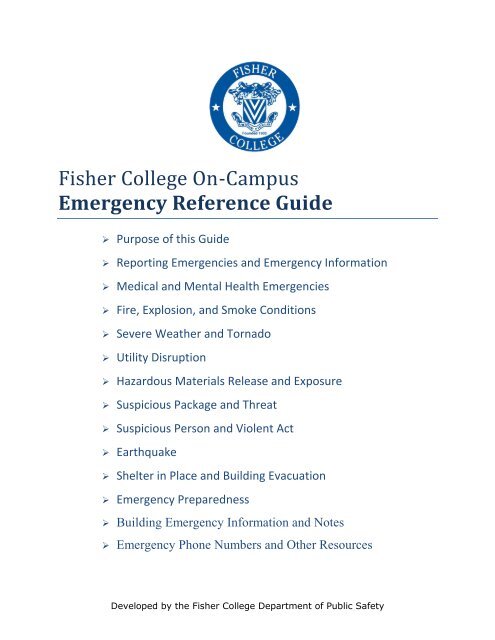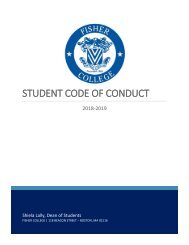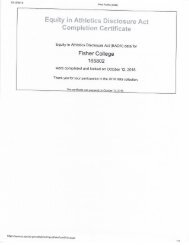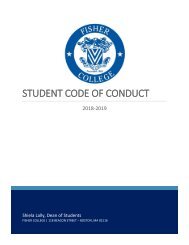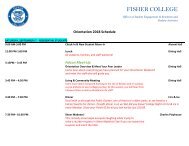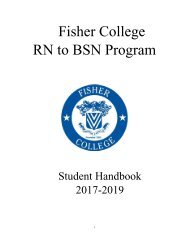Fisher College On-Campus Emergency Reference Guide
You also want an ePaper? Increase the reach of your titles
YUMPU automatically turns print PDFs into web optimized ePapers that Google loves.
<strong>Fisher</strong> <strong>College</strong> <strong>On</strong>-<strong>Campus</strong><br />
<strong>Emergency</strong> <strong>Reference</strong> <strong>Guide</strong><br />
‣ Purpose of this <strong>Guide</strong><br />
‣ Reporting Emergencies and <strong>Emergency</strong> Information<br />
‣ Medical and Mental Health Emergencies<br />
‣ Fire, Explosion, and Smoke Conditions<br />
‣ Severe Weather and Tornado<br />
‣ Utility Disruption<br />
‣ Hazardous Materials Release and Exposure<br />
‣ Suspicious Package and Threat<br />
‣ Suspicious Person and Violent Act<br />
‣ Earthquake<br />
‣ Shelter in Place and Building Evacuation<br />
‣ <strong>Emergency</strong> Preparedness<br />
‣ Building <strong>Emergency</strong> Information and Notes<br />
‣ <strong>Emergency</strong> Phone Numbers and Other Resources<br />
Developed by the <strong>Fisher</strong> <strong>College</strong> Department of Public Safety
Purpose of this <strong>Guide</strong><br />
<strong>Fisher</strong> <strong>College</strong> is committed to protecting the safety and wellbeing of all members of our<br />
community. Students, faculty, and staff can help the <strong>College</strong> safeguard the campus by taking<br />
preventative measures to ensure the safety and preparedness, and by referencing the guide in the<br />
event of an emergency.<br />
This guide is intended to serve as a quick reference in many different types of emergencies. This<br />
is not a comprehensive list of instructions and resources, rather a reminder of the basic steps that<br />
should be taken to minimize risks associated with a given hazard and to protect you and others<br />
from harm.<br />
You should review this guide and be familiar with its content before an emergency occurs.<br />
Because emergencies can vary greatly, the instructions provided by the <strong>College</strong> and emergency<br />
personnel at the time of the incident may change or even conflict with those listed in this<br />
document.<br />
ALWAYS FOLLOW THE INSTRUCTIONS OF COLLEGE AND EMERGENCY<br />
PERSONNEL<br />
Any questions or suggestions regarding the guide or <strong>Fisher</strong> <strong>College</strong>’s emergency procedures or<br />
response can be directed to the <strong>Fisher</strong> <strong>College</strong> Department of Public Safety at 617-236-8880.<br />
Reporting Emergencies and <strong>Emergency</strong><br />
Information<br />
How to Report and <strong>Emergency</strong><br />
For all on-campus emergencies requiring emergency services, (Police, Fire, Ambulance) contact<br />
911 or the <strong>Fisher</strong> <strong>College</strong> Police at 617-236-8880 from any phone.
When reporting emergencies:<br />
‣ You may hear multiple rings, but stay on the line until your call is answered.<br />
‣ Stay calm and carefully describe the problem and location with as much detail as<br />
possible.<br />
‣ Do not hang up until told to do so.<br />
‣ Follow any instructions that you are given.<br />
‣ Send someone to direct responders to your location, if possible. Wait for help to arrive.<br />
How to get Information in an <strong>Emergency</strong><br />
<strong>Fisher</strong> <strong>College</strong> will send out alerts through our <strong>Emergency</strong> Notification System (ENS). When<br />
this system is activated, you will receive a text message to your cell phone and an email to your<br />
<strong>Fisher</strong> Account.<br />
‣ In order to receive these alerts you must make sure your contact information is correct.<br />
‣ Be sure to alert others if you receive an emergency alert!<br />
During and emergency the <strong>Fisher</strong> website <strong>Fisher</strong>.edu will be updated with more specific<br />
instructions.<br />
Do not call the <strong>Fisher</strong> <strong>College</strong> Police for information on an emergency unless<br />
you are making a report or requesting assistance. Requests for information in<br />
an emergency can overwhelm the dispatcher and hinder emergency response.<br />
Medical and Mental Health Emergencies<br />
Medical Emergencies<br />
If you believe that someone is experiencing a medical emergency, contact 911 or the <strong>Fisher</strong><br />
<strong>College</strong> Police immediately at 617-236-8880. If you call 911 first, please call the <strong>Fisher</strong> <strong>College</strong><br />
Police to let them know what is happening.<br />
Updated May 2015
‣ Be prepared to provide specific information about your location and the nature of the<br />
emergency. It will be helpful to know if the individual is conscious, alert, breathing, or<br />
bleeding.<br />
Assist the victim-The following measures do not require training and cannot harm a person.<br />
Provide care following these instructions if it is safe and you are comfortable doing so.<br />
Heart Attack/Cardiac Arrest<br />
‣ If the person is unconscious and there is no pulse detected, attempt to wake them up by<br />
shaking them and speaking loudly directly to them.<br />
‣ If the person cannot be woken, provide the Hands-<strong>On</strong>ly CPR by placing your hands in the<br />
center of the person’s chest and compressing hard and fast. Do not be afraid, your<br />
actions can only help. Do not stop until the person regains consciousness or help<br />
arrives.<br />
‣ If there is an Automatic External Defibrillator (AED) present, open the AED and follow<br />
the AED’s audible instructions. An AED is placed by the <strong>Campus</strong> Police Desk at 116<br />
Beacon Street.<br />
Seizure<br />
‣ If a person appears to be having a seizure, do not restrain them or place anything in or<br />
near their mouth. Move objects away from them to prevent injury and attempt to<br />
protect their head.<br />
Protect the Airway<br />
‣ If the person is vomiting or has fluid in their mouth, roll them onto their side to clear the<br />
airway.<br />
Control Bleeding<br />
‣ If the person is bleeding, apply direct pressure to the bleeding and do not stop until help<br />
arrives.
Protect the Spine<br />
‣ If the person fell or hit their head, do not move them or allow them to move unless they<br />
are in immediate danger.<br />
Keep the Victim Comfortable<br />
‣ Keep the person comfortable and safe and do not allow them to take anything by mouth<br />
until responders arrive.<br />
Mental Health Emergencies<br />
‣ If you are concerned that someone is at risk of harming themselves or others, or is<br />
experience some type of psychological or mental health emergency:<br />
Contact Counselling at 617-236-8894<br />
‣ If the person might represent an immediate danger to themselves or others contact the<br />
<strong>Fisher</strong> Police at 617-236-8880. If there is a weapon involved, get to a safe area, call 911<br />
and then call <strong>Fisher</strong> <strong>College</strong> Police.<br />
‣ If you believe that your safety is threatened for any reason, leave the person and wait<br />
for the <strong>Fisher</strong> <strong>College</strong> Police to arrive<br />
‣ Do not allow this person to be alone or have access to potential weapons, if it is safe for<br />
you to do so.<br />
‣ If the person has sustained injury, provide medical care, if it is safe for you to do so.<br />
Fire, Explosion, and Smoke Conditions<br />
In Case of Fire<br />
If you smell smoke or see any evidence of smoke or fire, or the fire alarm activates in your<br />
building:<br />
Updated May 2015
‣ Immediately evacuate the building.<br />
‣ If an alarm is not already sounding, immediately activate the nearest fire alarm pull<br />
station.<br />
‣ If there are no fire alarms, knock on doors and yell “FIRE” as you evacuate.<br />
‣ Call 911 and contact <strong>Fisher</strong> <strong>College</strong> police at 617-236-8880 as soon as possible after<br />
evacuating the building.<br />
<strong>Fisher</strong> <strong>College</strong> policy requires all individuals to immediately evacuate the<br />
building when a fire alarm sounds. Immediately proceed to the nearest exit.<br />
If you are caught in smoke<br />
‣ Drop to your knees and crawl to the nearest exit (the air is cleaner near the floor).<br />
‣ Breathe through your nose and use a shirt or towel to breathe through if possible.<br />
If you are trapped in a building<br />
‣ Close all doors and windows.<br />
‣ Wet and place cloth material around and under the door to prevent smoke from entering.<br />
‣ Attempt to signal people outside of the building. Call 911 to report your location, and<br />
remain calm until help arrives.<br />
Consider using a fire extinguisher if the fire is small or if it is necessary to escape.<br />
If you do not feel safe or comfortable doing so, do not attempt to extinguish a fire unless it is<br />
necessary to do for your to escape.<br />
When using a fire extinguisher:<br />
‣ Stand a safe distance from the fire.<br />
‣ Pull the safety pin on the grip handle.<br />
‣ Aim at the base of the fire.<br />
‣ Squeeze the handles all the way together.<br />
‣ Sweep back and forth slowly until the fire is out or until you can escape.<br />
Building Evacuation<br />
Maps showing a means of egress can be found on the exit doors leading from each residential<br />
space and in hallways of other buildings. You should become familiar with at least two exit<br />
routes for all buildings that you frequent.<br />
Evacuation Procedures<br />
‣ Exit in an orderly fashion. Do not run or push. Running can lead to falls and injuries.
‣ Gather at a pre-designated meeting site a safe distance from the building, making care not<br />
to block exits.<br />
‣ Stay together and assess who is present. Faculty members, supervisors, and residence<br />
halls directors should gather names of students, employees, or residents present.<br />
‣ Report the condition and location of any people unable to leave the building or area or<br />
who need assistance evacuating to emergency responders.<br />
‣ Wait for the all clear from emergency personnel before attempting to re-enter a building<br />
or area.<br />
‣ Students, faculty, and staff will be directed to a temporary shelter if the building is<br />
deemed unsafe for a significant period of time.<br />
‣ Leave the building in an orderly manner using the nearest exit. DO NOT use elevators.<br />
‣ Feel closed doors with the back or your hand before opening. If a door is hot, DO NOT<br />
open it.<br />
‣ If it is safe to do so and you have time, close doors and windows behind you as you<br />
evacuate.<br />
Individuals with Disabilities:<br />
During an evacuation, follow the same procedure outlined above.<br />
‣ If you need assistance leaving a building or area, notify a friend, co-worker, roommate,<br />
etc. where you will be waiting.<br />
‣ Do not use an elevator during an evacuation.<br />
‣ Call 911 and let the dispatcher know your exact location.<br />
‣ Remain calm until help arrives.<br />
Severe Weather and Tornado<br />
Severe Weather – including lightning, hail, high winds, and tornadoes<br />
Weather Watch – is issued when the risk of hazardous weather has increased significantly. This<br />
means that severe weather is possible in your area. You should have a plan of action in case a<br />
storm threatens and continue to listen for updates and possible warnings especially when<br />
planning travel or outdoor activities.<br />
Weather Warning – is issued when severe weather is imminent or ongoing in your area. A<br />
Warning means that weather conditions pose a threat to life or property. You must take<br />
immediate protective action. When a Warning is issued in the area, you should immediately go<br />
indoors and shelter yourself from the severe weather event.<br />
Updated May 2015
If you see or hear threatening weather or hear that a Severe Weather Warning has been issued for<br />
your area:<br />
‣ Seek shelter immediately indoors and away from windows. Safe places include interior<br />
rooms and hallways on the lowest floors of buildings.<br />
‣ Close all doors and windows and stay away from exterior doors and windows.<br />
‣ Put as many walls and floors as possible between yourself and the exterior of the<br />
building.<br />
‣ DO NOT go outside until the storm has passed.<br />
Seek more information<br />
‣ Check the <strong>Fisher</strong> <strong>College</strong> website at www.fisher.edu or check your <strong>Fisher</strong> <strong>College</strong> email<br />
for more information.<br />
‣ Listen to weather radio or local media reports.<br />
‣ DO NOT call <strong>Fisher</strong> <strong>College</strong> Police unless you need emergency assistance.<br />
If you hear thunder or see lighting, follow the 30/30 rule:<br />
‣ If you see lighting and cannot count 30 before hearing thunder, you are within the range<br />
of a possible lighting strike.<br />
‣ Go indoors immediately and stay away from doors and windows. Do not use electronics<br />
including TV’s and computers. Do not use running water.<br />
‣ Remain indoors until 30 minutes after you see the last lighting or hear the last thunder,<br />
even if it is sunny or no longer raining outside. Lighting can jump up to 10 miles, and can<br />
strike even if it is not raining.<br />
If a Tornado Warning has been issued:<br />
TAKE SHELTER IMMEDIATLEY<br />
‣ Move to an interior hallway or room on the lowest floor of a building. Smaller rooms are<br />
safer than large rooms.<br />
‣ If possible and if it is safe to do so, alert others and encourage them to seek shelter.<br />
‣ If you are outdoors, immediately move to the nearest building and seek shelter in an<br />
interior room or hallway. Do not remain in a vehicle. Alert others to the oncoming<br />
tornado and encourage them to seek shelter.<br />
‣ Flying and falling debris causes most tornado injuries and fatalities. Make sure to protect<br />
yourself appropriately.
After the storm<br />
‣ Be careful of storm debris including downed tree limbs. Look out for downed utility<br />
wires and do not approach or touch downed wires for any reason. Assume all downed<br />
wires are live. Alert others to downed wires.<br />
‣ Check yourself and those around you for injury.<br />
‣ If you smell gas or hear a hissing sound, open windows and evacuate the building<br />
immediately.<br />
‣ Evacuate damaged buildings and do not re-enter buildings until the building is declared<br />
safe by authorities.<br />
‣ Call 911 or <strong>Fisher</strong> <strong>College</strong> police ONLY to report life-threatening injuries.<br />
Utility Disruption<br />
Gas Leak/Fumes<br />
If you suspect a gas leak or detect the scent of natural gas (smells like rotting eggs);<br />
‣ Immediately clear the area and leave the building. Do not use elevators. Go to your predetermined<br />
emergency meeting site.<br />
‣ DO NOT smoke cigarettes, light matches or candles, or do anything that might create<br />
heat or a spark. Do not use your cell phone until you leave the area of the suspected leak.<br />
‣ Leave ventilation systems on and open windows if it is safe to do so.<br />
‣ Contact <strong>Fisher</strong> <strong>College</strong> police at 617-236-8880 as soon as possible.<br />
o Be prepared to provide your location and the location of the odor and provide as<br />
many details as possible.<br />
‣ Do not attempt to turn off the gas on your own.<br />
‣ Help others who need assistance.<br />
‣ Stay away from the building until you are told by responders that it is safe.<br />
Power Outage<br />
If the power goes out in a room or part of a building, contact the Maintenance Department at<br />
617-236-8882.<br />
In a building-wide or after hour’s outage or an outage affecting multiple buildings contact <strong>Fisher</strong><br />
<strong>College</strong> Police at 617-236-8880.<br />
In a Power Outage:<br />
‣ Unplug nonessential major electronic equipment (computers, TVs, etc.) so that they are<br />
not damaged when power returns.<br />
‣ Take action to protect research, if applicable. Secure vital equipment, records, and<br />
hazardous materials if it is safe to do so. In a lab, open all ventilation hoods. If this is not<br />
Updated May 2015
possible, or natural ventilation is insufficient, leave the building immediately until power<br />
is restored.<br />
o If directed to do so, evacuate the building in an orderly manner.<br />
‣ Move cautiously to a lighted area. Exits may be indicated by lighted signs.<br />
‣ DO NOT light candles or use any other kind of flame for light. This represents a major<br />
fire hazard.<br />
‣ DO NOT use elevators to evacuate a building during a power outage.<br />
‣ Be prepared for multiple outages.<br />
‣ Assist others who need help evacuating, if possible.<br />
o Check www.fisher.edu or call 617-236-8880 for more information during a<br />
prolonged outage.<br />
Water Leak<br />
Report all water leaks immediately to the Maintenance Department at 617-236-8882 or <strong>Fisher</strong><br />
<strong>College</strong> Police at 617-236-8880 if a water leak occurs after hours.<br />
‣ If it is safe to do so, turn off all electrical devices.<br />
‣ If hazardous materials are involved, refer to the “Hazardous Materials” section of this<br />
document.<br />
‣ If a water leak is due to a storm, relocate to a safer area or alternate location.<br />
‣ Take actions to protect property. Unplug any electronics. Move things that may be<br />
damaged to an elevated area.<br />
‣ Use absorbent materials to contain the water and isolate the affected area if it is safe to do<br />
so.<br />
Hazardous Materials Release and<br />
Exposure<br />
Hazardous Material Release<br />
Hazardous materials are defined as any substance that causes or may cause adverse effects on<br />
health or safety or individuals, the general public, or the environment.<br />
If there has been a release of chemicals or exposure to potentially hazardous materials:<br />
AVOID FURTHER EXPOSURE TO THE HAZARD<br />
Contact <strong>Fisher</strong> <strong>College</strong> Police at 617-236-8880 as soon as it is safe to do so.<br />
‣ Be prepared to provide information about the name and quantity of the material, the<br />
location of the incident, number of people who have been injured or exposed, and if fire<br />
or explosion has occurred.
‣ Follow all instruction that you are given.<br />
If you believe that the area is unsafe, or are told by emergency responders, evacuate the area<br />
immediately<br />
‣ As you evacuate the area, alert others of the release and encourage them to leave the area,<br />
if it is safe to do so.<br />
‣ Assist others who need help evacuating.<br />
‣ Request that exposed individuals remain nearby until emergency responders arrive.<br />
‣ Isolate the area and wait for responders to arrive. Do not return to the area until you are<br />
told by responders that it is safe.<br />
If you are trained and can do so without risking exposing yourself to the hazard:<br />
‣ Turn off any sources of ignition.<br />
‣ If it is safe to do so, prevent further chemical release.<br />
‣ Attempt to prevent chemicals from entering drains by using absorbent material or by<br />
blocking drains.<br />
DO NOT RISK EXPOSING YOURSELF TO THE HAZARDOUS<br />
MATERIAL. DO NOT ATTEMPT TO CLEAN UP A SPILL OR RELEASE<br />
UNLESS YOU ARE TARINED AND HAVE THE PROPER EQUIPMENT.<br />
If the incident occurs outdoors, close doors and windows to isolate the area if possible<br />
‣ If you are outdoors during the emergency, you may be directed to go or stay indoors and<br />
shelter in place.<br />
‣ See “Shelter in Place” procedures for further instruction.<br />
Hazardous Material Exposure<br />
If you or someone else has been exposed to a hazardous material and if it is safe to do so:<br />
‣ Brush dry chemicals or material off of yourself or others.<br />
‣ Rinse the affected area with water for 15 minutes or until responders arrive. Utilize an<br />
emergency shower and/or eye wash station if available.<br />
‣ If illness or injury is present, provide care for the injuries if you are comfortable doing so.<br />
<strong>Reference</strong> the “Medical <strong>Emergency</strong>” section of this guide.<br />
‣ Notify emergency responders of the exposure immediately.<br />
Updated May 2015
Suspicious Package and Threat<br />
Suspicious Package<br />
A suspicious package may contain dangerous items or substances. Some typical characteristics<br />
that should trigger suspicion include packages that:<br />
‣ Have protruding wires or aluminum foil, strange odors, or stains.<br />
‣ Are of unusual weight given their size, are lopsided or oddly shaped.<br />
‣ Are marked with threatening language.<br />
‣ Have excess postage or packing material, like tape or string.<br />
‣ Are unattended bags under suspicious circumstances.<br />
o An unattended bag or package is not necessarily suspicious. It is important to<br />
consider the circumstances.<br />
o If you witness a person deliberately place a bag somewhere and leave the area,<br />
this may be cause for suspicion.<br />
If you receive or notice a package or container that you consider to be suspicious:<br />
‣ Do not go near, touch, or otherwise disturb the package.<br />
o If you are holding the package, put it down gently on solid surface or on the floor.<br />
o If there is powder or liquid coming from the package, try to set it down in a<br />
container like a trash can, or bucket.<br />
‣ Do not activate the fire alarm system and do not use a cell phone near the package.<br />
‣ Note the area the package is found for anything else out of place or odd.<br />
Avoid the immediate area where the package is located and alert others to avoid the area:<br />
‣ Contact <strong>Fisher</strong> <strong>College</strong> Police at 617-236-8880 immediately and provide as much<br />
information as possible about the object and location.<br />
‣ Notify your supervisor and/or staff.<br />
o Prepare to evacuate the building. Evacuate ONLY if told by responders to do so.<br />
o As you evacuate, be alert for anything that appears suspicious. Report anything<br />
suspicious to the authorities. Prepare to meet responding police officers and<br />
provide as much information as possible.<br />
Threat<br />
If you receive a threat of any kind:<br />
‣ Record the time that the threat was received.
‣ Try to record the threat exactly as it was said or written. Be clear about the type of threat<br />
being made.<br />
‣ If you receive a threatening email, letter, phone call, or any other kind of threat, report it<br />
immediately to <strong>Fisher</strong> <strong>College</strong> Police at 617-236-8880.<br />
If you receive a threat via phone call:<br />
‣ If your phone has Caller ID, record the number that is displayed.<br />
‣ Try to record the threat exactly as it is said. Try to keep the caller on the phone long<br />
enough to ask questions and record details about the following:<br />
o What will happen?<br />
o Where will it happen?<br />
o When will it happen?<br />
o How can it be stopped?<br />
‣ Report all threats immediately to <strong>Fisher</strong> <strong>College</strong> Police at 617-236-8880. Notify your<br />
supervisor and prepare to meet responding police officers. Provide as much information<br />
to them as possible.<br />
o Do not activate the fire alarm system. Evacuate the area only if told by responders<br />
to do so.<br />
Suspicious Person and Violent Act<br />
Suspicious Person<br />
A suspicious person could be someone displaying erratic behavior or someone who appears “out<br />
of place” for a given area or time of day. Suspicious behavior could include attempting to gain<br />
entry to vehicles or buildings, climbing fences, or loitering in an unusual area.<br />
If you witness someone who appears suspicious or who is displaying suspicious behavior:<br />
‣ Avoid the person and the area where they are located. Do not confront the person or<br />
prevent them from leaving the area.<br />
‣ Report suspicious persons or suspicious behavior to <strong>Fisher</strong> <strong>College</strong> Police immediately at<br />
617-236-8880.<br />
o You may hear multiple rings, but stay on the line until your call is answered.<br />
o When reporting to <strong>Fisher</strong> <strong>College</strong> Police, make sure to provide details about the<br />
individual’s location, appearance, direction or travel, and specific behavior or<br />
appearance that you believe to be suspicious.<br />
Updated May 2015
Violent Act<br />
Violence can come in many forms including domestic and workplace violence. In any situation<br />
where you feel that someone may threaten the safety of you or your classmates, coworkers,<br />
friends, or roommates, it is important that you contact the <strong>Fisher</strong> <strong>College</strong> Police as soon as<br />
possible. In situations such as these, do not confront the person from leaving the area, and make<br />
sure to leave yourself a route of escape.<br />
Active Shooter<br />
In any situation where you believe that a person may be threatening your safety, particularly if<br />
the person is carrying a weapon or you hear something that sounds like gunshots, it is most<br />
important that you shelter in place and prevent the person from gaining access to the room or<br />
area that you occupy – DO NOT investigate a person or situation where your safety may be<br />
threatened.<br />
‣ If it is possible and safe for you to evacuate the building, run to the nearest exit. As you<br />
exit, warn others from entering the building or area.<br />
If you are unable to evacuate, go to a room that can be locked or otherwise secured from<br />
inside, if it is safe to do so:<br />
‣ Close and lock all doors and windows. If the door does not lock, barricade the door with<br />
heavy furniture such as bookcases, desks, or file cabinets.<br />
‣ Turn off all lights, get everyone down on the floor, and ensure that no one is visible from<br />
outside of the room.<br />
o If you hear a voice stating that it is safe to come out, make sure that it is a police<br />
officer or university official before emerging. This may be an attempt to lure you<br />
from your place of safety.<br />
If an active shooter enters your area of safety, call 911 and alert them to the location of the<br />
shooter. If you cannot speak, leave the line open so that the dispatcher can hear what is going<br />
on around you. If possible, notify <strong>Fisher</strong> <strong>College</strong> Police as soon as possible at 617-236-8880.<br />
‣ If there is no opportunity for escape, attempt to shield yourself with an object, such as a<br />
desk, bag, or computer.<br />
o It may be possible to negotiate with the individual.<br />
o Attempting to overpower the individual involves significant risk and should be<br />
considered an absolute last resort after all other options have been exhausted.<br />
‣ If the person leaves the area, immediately proceed to a safer area and do not touch<br />
anything that was in the person’s vicinity.
FOLLOW ALL DIRECTIONS GIVEN BY POLICE OFFICERS. KEEP<br />
YOUR HANDS VISIBLE AT ALL TIMES.<br />
Keep in mind that the entire area is a crime scene, and you will not be allowed to leave the area<br />
until all witnesses have been identified and questioned. Remain in the designated assembly area<br />
and follow the instructions of emergency responders.<br />
If you encounter a shooter when you are outdoors, get indoors if possible. If this is impossible,<br />
find cover or something to hide behind:<br />
‣ Brick walls, large trees, parked cars, and other objects like this are appropriate cover.<br />
Earthquake<br />
In Case of Earthquake<br />
If the ground or a building that you are in begins to shake:<br />
If you are outdoors:<br />
‣ Stay outdoors. Do not attempt to enter a building.<br />
‣ Move away from trees, poles, and buildings.<br />
If you are indoors:<br />
‣ Stand in a doorway or get underneath a sturdy piece of furniture such as a table or desk.<br />
‣ Stay away from windows, hanging fixtures, or furniture that may topple or fall off the<br />
wall.<br />
‣ Hold on to the doorway or the leg of a desk or table and use your arms to protect your<br />
face, head, and neck.<br />
‣ Stay where you are until the shaking stops.<br />
‣ Be aware that the power may go out and that fire alarm or sprinkler systems may activate.<br />
After the shaking stops, evacuate the building immediately<br />
‣ Proceed with caution to the nearest exit. DO NOT use elevators.<br />
‣ Assist others who need help evacuating.<br />
o If someone is unable to evacuate, tell them to wait by the nearest stairwell.<br />
o Individuals unable to evacuate should call <strong>Fisher</strong> <strong>College</strong> Police at 617-236-8880<br />
and remain calm until help arrives.<br />
Updated May 2015
‣ <strong>On</strong>ce you are out of the building, assemble with others a safe distance from the building<br />
(at the designated meeting site, if you know where that is).<br />
o Notify emergency responders of the locations of people who are trapped, injured,<br />
or unable to evacuate.<br />
o Do not re-enter the building until you are told by emergency responders that it is<br />
safe to do so.<br />
o If individuals are injured, provide care if you are comfortable doing so. Refer to<br />
the “Medical <strong>Emergency</strong>” section of this document.<br />
o <strong>Emergency</strong> lines should be kept open for true emergencies. Do not call 911 or<br />
<strong>Fisher</strong> <strong>College</strong> Police unless a life-threatening emergency exists.<br />
If you are trapped by debris:<br />
‣ Do not light a match or use any source of flame.<br />
‣ Remain as still as possible to avoid kicking up dust.<br />
‣ Cover your mouth with clothing, if possible.<br />
‣ Tap on a pipe or wall so that rescuers can locate you.<br />
‣ Shout only as a last resort. Shouting can cause you to inhale dangerous amounts of dust.<br />
Shelter in Place and Building Evacuation<br />
Shelter in Place<br />
In emergencies where the risk is outside (e.g., severe weather, airborne toxin or chemical,<br />
violent act), it is important to minimize exposure to the hazard. In circumstances such as<br />
these, follow this Shelter in Place procedures.<br />
If you have heard the terms "Shelter in Place" and "Lockdown" and been confused as to what the<br />
difference is, don't worry, you are not alone. The distinction is not necessarily intuitive, but it is<br />
important. The key thing to remember is that both are instructions to put effective barriers<br />
between you and a threat. The difference is in the types of threat, and what kind of barrier is<br />
called for.<br />
A shelter in place is the use of a structure and its indoor atmosphere to temporarily separate you<br />
from a hazardous outdoor atmosphere. This can be because of a hazardous material incident, or
perhaps a weather related emergency. It entails closing all doors, windows and vents and taking<br />
immediate shelter in a readily accessible location.<br />
A lockdown may be instructed during situations such as the presence of a hostile or armed<br />
intruder inside a building. A lockdown requires locking doors, windows, and barricading oneself<br />
to block entry to a campus facility, a classroom, or to an office suite. <strong>Reference</strong> the “Suspicious<br />
Person or Violent Act” procedure for further information.<br />
You may determine on your own that it is most safe to shelter in place. If this is the case, do so<br />
until you receive instructions to do otherwise, or until it becomes unsafe to shelter in place. You<br />
may receive an emergency alert via text message or email instructing you to shelter in place. In<br />
these cases:<br />
‣ Immediately enter the nearest building if you are not indoors. Remain indoors until<br />
directed by emergency responders.<br />
‣ Faculty members who are conducting class should remain in their classroom.<br />
‣ Close all doors and windows, turn off air conditioning or heating units where possible,<br />
and await further instructions.<br />
‣ Stay away from doors and windows.<br />
‣ Faculty, Staff, and Supervisors should assist in maintaining order.<br />
‣ Remain sheltered indoors until told by emergency personnel that it is safe to go outside.<br />
<strong>Emergency</strong> Preparedness<br />
Tips to Help You Prepare for Emergencies<br />
Be Informed:<br />
‣ Know what types of hazards are common in your area and what you should do and where<br />
you should go should an emergency occur.<br />
‣ Attend safety and security information sessions and classes.<br />
‣ Know how to get official information in case of an emergency.<br />
‣ Update your contact information through the <strong>Fisher</strong> <strong>College</strong> Portal at<br />
http://portal.fisher.edu.<br />
Updated May 2015
‣ Program a family member or close friend into your cellphone as ICE (In Case of<br />
<strong>Emergency</strong>) in the name field. <strong>Emergency</strong> responders can use this to contact someone<br />
you designate if you are incapacitated.<br />
‣ Refer to Ready.gov to be fully informed and prepared for any emergency.<br />
Be Prepared:<br />
‣ Review this guide. Be familiar with how to obtain information from it if needed.<br />
‣ Take responsibility for your own preparedness by taking steps to educate and equip<br />
yourself for an emergency.<br />
‣ Develop a plan to communicate with your family and friends during an emergency.<br />
o Designate a single contact outside of your area – be sure that family and friends<br />
know who the contact is and how to reach them.<br />
o Notify family and friends if you are affected by an emergency so they know<br />
where you are and that you are safe. If you can’t reach them, notify your<br />
designated contact person.<br />
‣ Learn CPR and First Aid. These skills might save a life, including your own.<br />
Develop a personal emergency plan for your school or workplace and residence which<br />
includes:<br />
‣ Know two ways out of all rooms, and the location of the nearest fire extinguisher.<br />
‣ Pre-designate meeting places for family, friends, co-workers, and/or roommates.<br />
o <strong>On</strong>e location just outside of where you live/work.<br />
o A second location further away in case you can’t get close to where you<br />
live/work.<br />
Develop an <strong>Emergency</strong> Supply Kit for your comfort and safety during an emergency.<br />
A complete <strong>Emergency</strong> Supply Kit should include:<br />
Bottled Water<br />
Canned or Packed Food<br />
Manual Can Opener<br />
Battery or Crank-Powered Radio<br />
Flashlight<br />
<strong>Emergency</strong> Light Sticks<br />
Extra Batteries for Radio and Light<br />
First Aid Kit<br />
Toiletries<br />
Toothbrush and Toothpaste, Shampoo, Soap, Comb/Brush<br />
<strong>Emergency</strong> Blanket
Prescription Medications (if taken)<br />
Safety Whistle (to attract attention)<br />
Dust Mask & Medical Gloves<br />
Hand Sanitizer<br />
Don’t forget your:<br />
Keys<br />
Photo identification<br />
Wallet/Purse<br />
Money/Credit Cards<br />
Cellphone and Charger<br />
Updated May 2015


